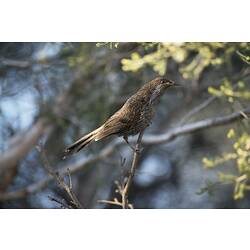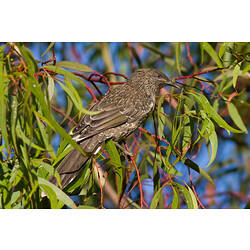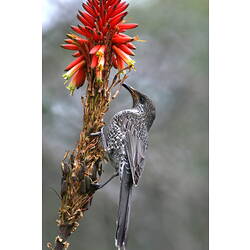General Description
The Little Wattlebird is the smallest of Australia's wattlebirds. Their body is dark brown-grey with white streaks. Wings have large red-brown (chestnut) patches visible in flight. Bill to tail length of up to 33 cm. Characteristically lacks wattles. Little Wattlebirds look quite similar to Red Wattlebirds, Anthochaera carunculata, which they are often found with. Red Wattlebirds are larger, with yellow underparts and red wattles on their cheeks.
Biology
Little Wattlebirds make distinctive loud clucking calls, usually accompanied by head and tail movements. They also clash their bills together while calling, producing a loud noise (bill-clattering). As a honeyeater, Little Wattlebirds feed on nectar collected using a long, specially adapted brush-tipped tongue. They also eat flowers, berries, seeds and insects. Mainly feed while perched, but can catch insects during flight. Nests are built by the female, using twigs and grass to form a large cup-shape nest lined with bark, feathers and grass. Females will incubate one to two eggs, with both parents caring for the young. Can have up to three broods each year.
Distribution
South-eastern and south-western mainland Australia and Tasmania.
Habitat
Heaths, forests, coastal woodlands and urban areas.
More Information
-
Animal Type
-
Animal SubType
-
Brief Id
Small dark grey wattlebird with white streaks and a raucous call. Lacks wattles.
-
Colours
Brown, White
-
Maximum Size
33 cm
-
Habitats
-
Diet
Nectar
-
Endemicity
-
Conservation Statuses
CITES: Not listed, FFG Threatened List: Not listed, EPBC Act 1999: Not listed, IUCN Red List: Least Concern
-
Taxon Name
-
Scientific Author
(Latham, 1801)
-
Common Name
Little Wattlebird
-
Kingdom
-
Phylum
-
Subphylum
-
Class
-
Order
-
Family
-
Genus
-
Species Name
chrysoptera









